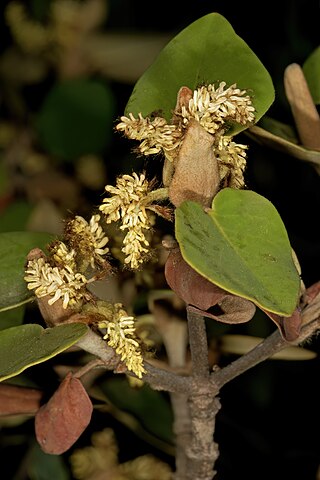
Androstachys johnsonii, the Lebombo ironwood, is a medium-sized Afrotropical tree species, and the sole member of the genus Androstachys in the Picrodendraceae. It is slow-growing, evergreen to deciduous, and dioecious, with flowers that are wind-pollinated. It is native to southeastern Africa and Madagascar, where it generally occurs gregariously on rocky hillsides, particularly in hot and dry situations. It produces a hard, durable wood which is of economic interest. Its specific name commemorates W. H. Johnson, a 19th-century Director of Agriculture in Mozambique. Four related species which are native to Madagascar, are usually placed in genus Stachyandra.

Adansonia perrieri, or Perrier's baobab, is a critically endangered species of deciduous tree, in the genus Adansonia. This species is endemic to northern Madagascar. It has been documented in only 10 locations, including the Ankarana, Ampasindava, Loky Manambato and Montagne d'Ambre protected areas. Most populations, however, are outside of protected areas. Each location has few individuals. With an estimated population of fewer than 250 mature individuals and ongoing habitat decline due to fire and cutting for charcoal and timber or clearing for mining, this species has been assessed by IUCN as Critically Endangered. There are three species of baobab found in northern Madagascar, all sharing the common name "bozy".

Wrightia tinctoria, Pala indigo plant or dyer's oleander, is a flowering plant species in the genus Wrightia found in India, southeast Asia and Australia. It is found in dry and moist regions in its distribution. Various parts of the plant have been used in traditional medicine, but there is no scientific evidence it is effective or safe for treating any disease.

Capparis tomentosa, the woolly caper bush or African caper, is a plant in the family Capparaceae and is native to Africa.
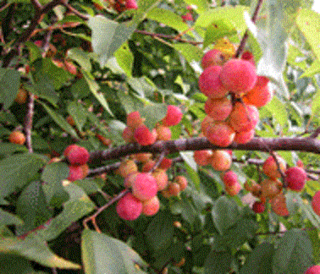
Prunus rivularis, known variously by the common names creek plum, hog plum, or wild-goose plum is a thicket-forming shrub. It prefers calcareous clay soil or limestone-based woodland soils. This deciduous plant belongs to the rose family, Rosaceae, and is found mainly in the central United States. It is a shrub consisting of slender stems with umbel clusters of white blossoms. The fruit is a drupe that resembles a large berry; though it has a bitter taste, it serves as a source of food for birds and other wildlife. "Prunus" is Latin for plum, whereas "rivularis" means being near a stream.

Ardisia solanacea, called shoebutton ardisia in English, is a species of the genus Ardisia in family Primulaceae.
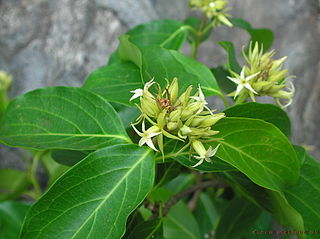
Aganosma cymosa is a liana that can grow up to 10 m (33 ft) in length, pale brownish tomentose. Leaf-stalks are 1–2 cm (0.4–0.8 in), leaf blade broadly ovate or orbicular, 5–16 cm (2.0–6.3 in) by 4–12 cm (1.6–4.7 in), base rounded or obtuse, apex acuminate or obtuse, rarely retuse, lateral veins eight to ten pairs. Flowers are borne in many-flowered clusters at branch ends, which are carried on stalks up to 6 cm (2.4 in). Bracts and bracteoles are very narrowly elliptic, about 1 cm (0.4 in) long. Flower-stalks are about 5 mm (0.2 in). Calyx with several glands inside margin of sepals; sepals very narrowly elliptic, about 1 cm (0.4 in), pubescent on both surfaces. Flowers are white, minutely tomentose outside, glabrous at throat; tube shorter than sepals, 6–7 mm (0.2–0.3 in); lobes oblong, as long as tube. Disc longer than ovary. Ovary pubescent at apex. Follicles 2, cylindric, to 30 cm (12 in) by 0.8–1.2 cm (0.3–0.5 in), yellow hirsute. Seeds oblong, 1–2 cm (0.4–0.8 in) by about 5 mm (0.2 in), coma 2–4.5 cm (0.8–1.8 in). It is native to China, Bangladesh, India, Sri Lanka, and Indochina.
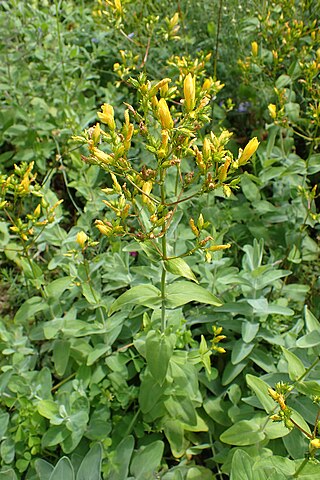
Hypericum annulatum is a species of flowering plant in the family Hypericaceae. It is a perennial herb of varying heights which grows upright, with more than a hundred flowers of a golden yellow color. First described in 1827, the species has a wide distribution from Eastern Europe to East Africa, and its appearance can vary greatly based on its geographic location. It has been used in Bulgarian folk medicine, and has more recently been investigated for its effectiveness in slowing the growth of or killing certain types of human cancer.

Muniria quadrangulata is a flowering plant in the mint family Lamiaceae and is endemic to Arnhem Land in the Northern Territory. It is a shrub with its branches and leaves covered with a thick layer of woolly hairs and pale yellow flowers in groups of up to nine, surrounded by woolly hairs.
Muniria angustisepala is a flowering plant in the mint family Lamiaceae and is endemic to the Northern Territory. It is an erect shrub with softly hairy, warty leaves and pale yellow, woolly flowers.
Muniria megalophylla is a flowering plant in the mint family Lamiaceae and is endemic to Arnhem Land in the Northern Territory. It is a shrub with its branches and leaves densely covered with a layer of short, greyish, branched hairs and small groups of reddish-pink flowers near the ends of the branches.

Quoya loxocarpa is a flowering plant in the mint family Lamiaceae and is endemic to Western Australia and the Northern Territory. It is an open shrub with many spindly tangled branches. The leaves are oblong and woolly when young and the flowers are whitish pink with purple spots inside and are surrounded by woolly sepals.

Cadaba farinosa is a 2–8 m (6.6–26.2 ft) high evergreen shrub or small tree that belongs to the caper family. It has simple ovate leaves with entire margins, zygomorphic, spidery, greenish, yellowish, whitish or pinkish flowers, and is covered in powdery hairs or scales, particularly the younger parts. It can be found in a zone from Senegal to India between the desert and the savanna.

Quoya verbascina, commonly known as golden bush, is a flowering plant in the mint family Lamiaceae and is endemic to Western Australia. It is an erect shrub with its branches and leaves densely covered with woolly hairs. The leaves are often oblong but very variable in shape and the flowers are pinkish-white with pink spots inside and are surrounded by yellow woolly sepals.

Harpullia cupanioides is a plant in the Sapindaceae family found in south east Asia: in the Andaman Islands, Assam, Bangladesh, Borneo, Cambodia, Yunnan, Hainan, Jawa, Laos, the Lesser Sunda Islands, Malaysia, Myanmar, New Guinea, Nicobar Islands, the Philippines, the Solomon Islands, Thailand, and Vietnam.

Goethalsia is a monotypic genus of flowering plants belonging to the family Malvaceae. It only contains one species, Goethalsia meiantha(Donn.Sm.) Burret It is within the Grewioideae subfamily.

Zanthoxylum avicennae is a woody plant in the family Rutaceae.
Zanthoxylum molle is a woody plant from the Rutaceae family.

Casearia tomentosa, commonly known as the toothed leaf chilla, is a species of flowering plant in the family Salicaceae, native to the Indian Subcontinent and Myanmar. It is one of 1,000 species that can be found in the Salicaeceae family.
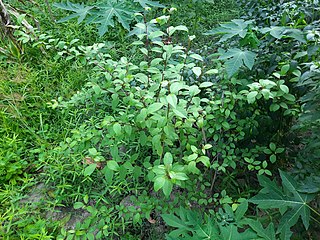
Commiphora madagascariensis, with the common name Madagascar corkwood, is a flowering plant in the family Burseraceae. The species is native to Tanzania, introduced into India.

















